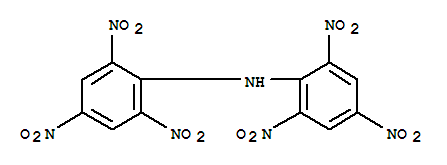supplier list
- No suppliers.

Hazard E: Explosive;T+: Very toxic;N: Dangerous for the environment;
Risk R2
Safety
Safety Information of 2,2',4,4',6,6'-Hexanitrodifenylamin (CAS No.131-73-7):
Hazard Codes:  E,
E, T+,
T+, N
N
Risk Statements: 2-26/27/28-33-51/53
R2:Risk of explosion by shock, friction, fire or other source of ignition.
R26/27/28:Very toxic by inhalation, in contact with skin and if swallowed.
R33:Danger of cumulative effects.
R51/53:Toxic to aquatic organisms, may cause long-term adverse effects in the aquatic environment.
Safety Statements: 35-36-45-61
S35:This material and its container must be disposed of in a safe way.
S36:Wear suitable protective clothing.
S45:In case of accident or if you feel unwell, seek medical advice immediately (show the label whenever possible.)
S61:Avoid release to the environment. Refer to special instructions / safety data sheets.
RIDADR: 0079
HazardClass: 1.1D
| Organism | Test Type | Route | Reported Dose (Normalized Dose) | Effect | Source |
|---|---|---|---|---|---|
| rat | LD | oral | > 500mg/kg (500mg/kg) | National Academy of Sciences, National Research Council, Chemical-Biological Coordination Center, Review. Vol. 5, Pg. 11, 1953. |
Home | About Us | Service | Links | Add to Favorite
Copyright©2011 HiIntermediates ICP: B2-20090288 浙ICP备09045134号-49